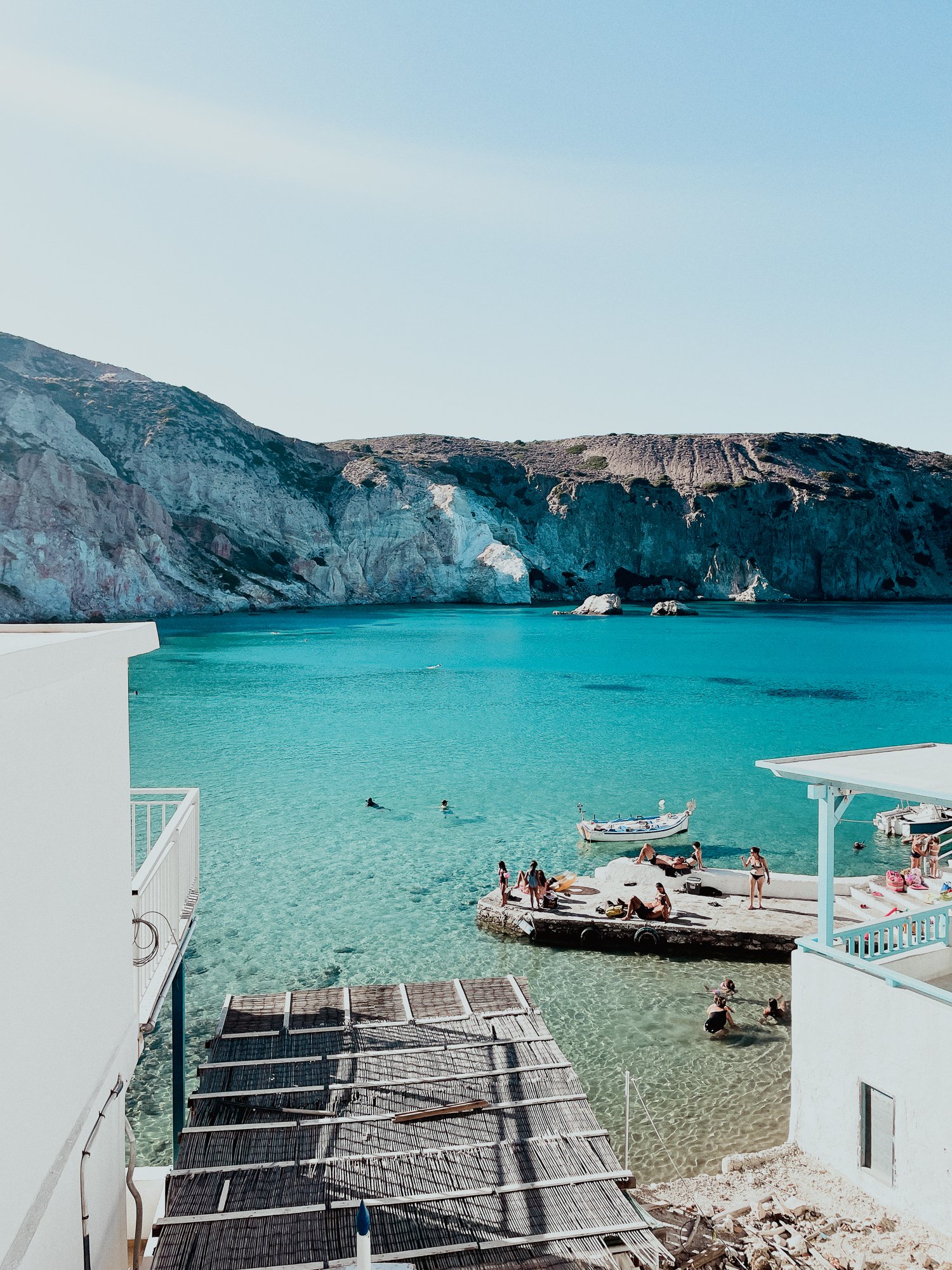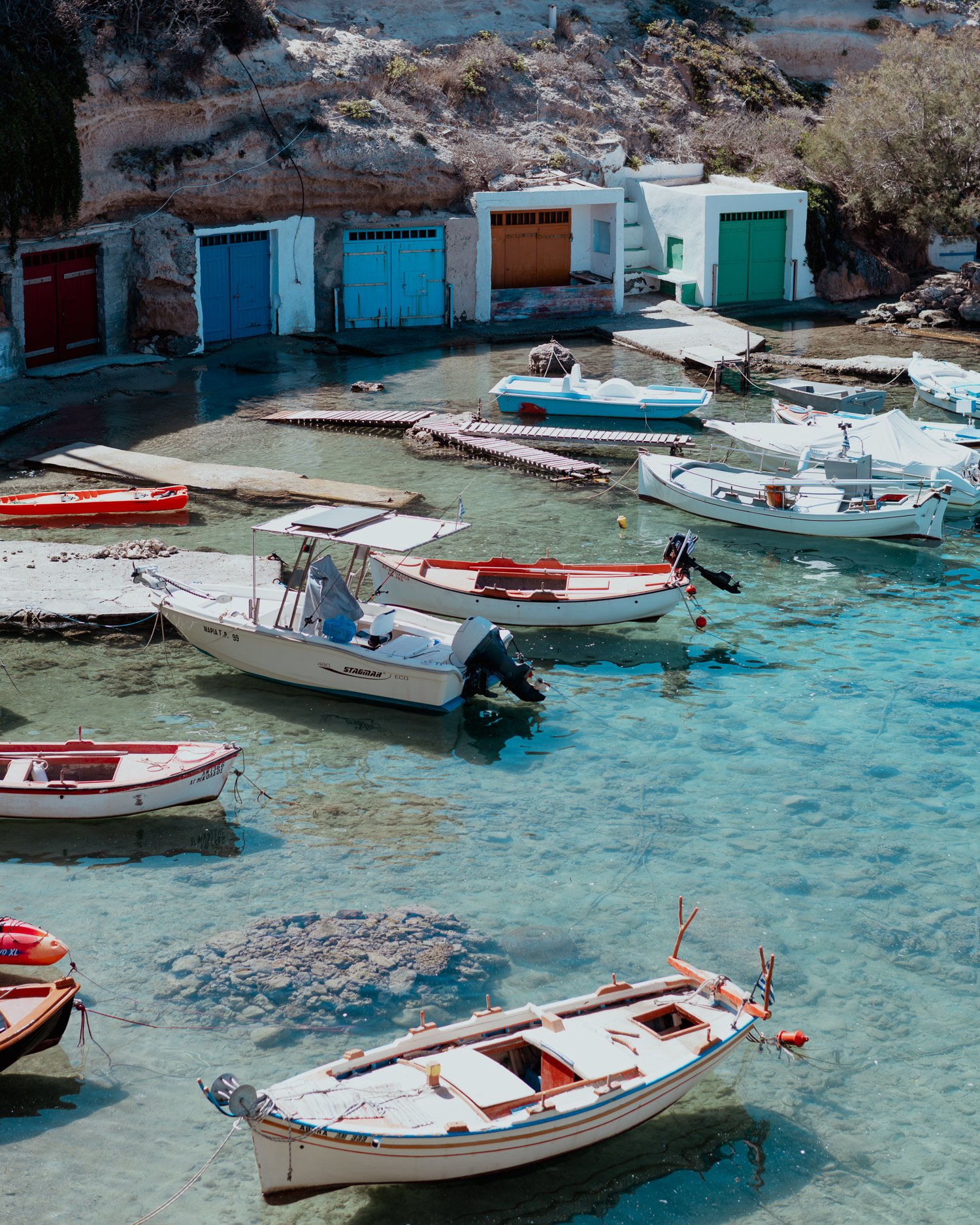10 tips for traveling in the Greek islands
Cycladic dwellings on the hillside in Oía, Santorini
#1 The Greek islands are seasonal
Summer is the best time to visit the Greek islands. Why? There are a few reasons. Number one being the warm weather. Number two because the islands virtually shut down during the fall and winter. The islands depend almost entirely on tourism, so it’s common for workers at hotels, shops and restaurants to head back to Athens (or other home countries) to their alternate jobs when the tourist season ends. It doesn’t mean visiting the Greek islands during winter is off limits, but keep in mind that the weather will be colder and wetter, and you’ll have far less selection of places that are open for business.
Crystal blue waters and white rocks in Milos, Greece
#2 Tap water isn’t drinkable
In the Greek islands, all drinkable water has to be brought in by boat. This water is what’s served at restaurants and cafés. Tap water on the other hand comes from desalination plants, so you wouldn’t necessarily be getting sick from exposure to bacteria but rather the high salt and mineral content that also gives the water an unpleasant, brackish flavor. Be prepared to buy bottled water for drinking (we used it for brushing our teeth too just to be safe). Finding bottled water is very convenient, with many hotels and shops selling large bottles for cheap.
#3 Tipping is optional
Unlike in the U.S., tipping at dining establishments is not expected in Greece. Food and hospitality services are highly regarded careers in Greece, and restaurant owners and staff take great pride in the experiences they create. They are compensated adequately, but a special tip for exceptional service would be welcomed. Even something like 10% is enough to give an extra thank-you.
Cocktails at Heliotopos Wine Bar in Imerovigli, Santorini
#4 Bring water shoes
If you’re planning to do any exploring along the coast, we HIGHLY recommend wearing a pair of water shoes with good grip. Much of the beauty of the Greek islands lies in its jagged, rocky landscape that creates the striking, crystal clear waters. But this terrain can also be sharp and treacherous to bare feet. Sarakiniko Beach in Milos is a perfect example where we greatly appreciated having water shoes. From afar the white, moonscape-like rocks appear smooth, but they’re actually full of thin, sharp rivets. Having a good pair of water shoes will allow you to explore the coastline worry and injury free.
On the cliffs at Papafragas Beach in Milos, Greece
#5 Make dinner reservations
It’s common practice in Greece to have dinner reservations every night. On more popular islands like Santorini, this is an absolute must especially during high-season. If you choose to be a walk-in, you may be waiting for hours or possibly not be able to get a table at all. For more popular establishments you may need to call a few weeks out, but for most restaurants just calling the evening before or day-of is sufficient.
Dinner near the water at Sunset Ammoudi in Santorini
#6 Ask for your check after dinner
Also on the topic of food, this is another little quirk that could be frustrating for first-time (American) visitors. In Greece, and much of Europe, you must ask for your check at the end of your meal to let the staff know you’re ready to leave. Unlike in the U.S. where restaurants rush the bill to you before you’re even finished eating to fill your seats with new customers, meals in Greece are meant to last A LOT longer. So sit back, relax and enjoy some post-meal conversation. Your waiters aren’t ignoring you, they’re just being polite and letting you stay for as long as you need.
Firopotamos Beach in Milos, Greece
#7 Prepare for wind and chilly evenings
We’re from California which has a strikingly similar climate to Greece, so this one didn’t take us by surprise, but it may for travelers from other regions. Summer in the Greek islands is sunny and hot during the day, but the nights can drop into the low 60ºF range, so just be prepared clothing-wise for those cool evenings. As well, the islands are also known for their high winds, which can make a big difference on the roughness of the sea. Boat excursions sometimes have to be rescheduled depending on the conditions. And if you’re planning to do any cliff jumping, it’s a good idea to check the weather and pick the least windy day for calmer waters.
Exploring the moonscape terrain of Sarakiniko Beach
Multicolored boat houses at Mandrakia in Milos, Greece
Greek ferries are the primary mode of transport between islands, but the process can be a bit intimidating and frustrating for first-time visitors. Patience and good attitude will get you through.
First, It’s a good idea to book your tickets ahead of time on sites like ferryscanner.com. There are different classes of seats just like an airline and drinks and food are available onboard for purchase. At this point, you will ONLY be given a confirmation. Your physical tickets (required to board) need to be picked up at the port on the day of departure or delivered to your hotel. Get to the port early (a few hours) as there will be lines. If you have extra time, just relax at a nearby café and use a vessel finder app to watch your ship’s progress.
Ferries often get behind schedule, but when they arrive at the port the process goes VERY rapidly, so be prepared to move quick. Passengers, cars and cargo all move onto the ship at the same time in a big herd. Luggage is stored below deck on shelves that are marked with the destinations. We found that these racks often fill up quickly, and you may just have to pile your luggage on the floor near it. It felt a bit weird to leave our belongings in such a haphazard manner, but we never had an issue.
Next, everyone heads upstairs to their seats. They’ll be checking tickets at this point, so there’s often a line which can move slow. You’re free to move about the ship and purchase food from the snack bars. When you hear your destination being announced, make your way to the exit. Be aware that the suitcases might not be in the same spot you left it, as they get shifted as passengers come and go. Sometimes ours were piled alongside others, so just make sure you locate and grab yours before exiting.
Crowd of passengers boarding a Greek Ferry at the port in Santorini
#9 Be ready for lots of stairs
The Greek islands are very hilly — and with hills come stairs. Be prepared to be going up and down many flights of stairs during your visits to the islands. In locations like Santorini this is even more extreme, with many properties built on steep inclines that require several flights to reach your room. Furthermore, many of the steps are uneven, so just make sure you pack some good walking shoes to help you make it up and down. If you have mobility issues, just be sure to check where your property is located or request a room closer to the main level.
Staircase weaving through Kastro Oía House in Santorini
#10 International driving license
For anyone outside the EU, you’ll need to obtain an international driving permit if you plan to operate a vehicle on the roads. One of the best ways to move freely about the Greek islands is to rent a car, motorcycle or ATV. The highways can be a bit intimidating on busier islands like Mykonos or Santorini, but it’s still one of the best ways to visit archeological sites and secluded beaches. In the U.S., you can obtain your international driver’s license at an AAA location.
Our buggy on the cliffs at Tsrigrado Beach in Milos
And that’s it! Greece is a wonderful country to experience, full of so much beauty and culture. Hopefully you find these tips helpful as you plan your Greek island adventure. If you have any specific questions, feel free to contact us or message us on Instagram and we’d love to help.
⚲ Pin it! Save this post to Pinterest.
About Us
We’re Rob and Lauren — a designer & photographer duo passionate about travel. We hope you find some travel inspiration here and the courage to go book that dream vacation.
With so many beautiful places, we can’t help but feel that somewhere is always waiting to be discovered.














